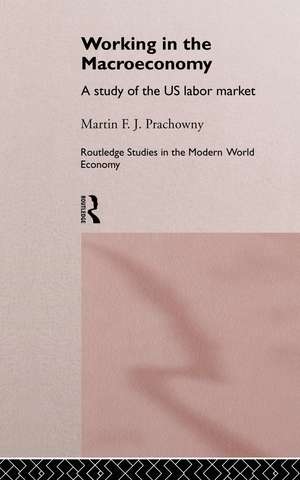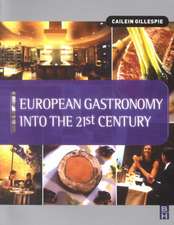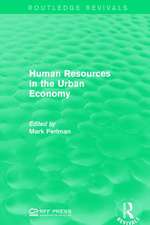Working in the Macro Economy: A study of the US Labor Market: Routledge Studies in the Modern World Economy
Autor Martin F. J. Prachownyen Limba Engleză Hardback – 17 apr 1997
| Toate formatele și edițiile | Preț | Express |
|---|---|---|
| Paperback (1) | 442.68 lei 6-8 săpt. | |
| Taylor & Francis – 2 dec 2014 | 442.68 lei 6-8 săpt. | |
| Hardback (1) | 1109.18 lei 6-8 săpt. | |
| Taylor & Francis – 17 apr 1997 | 1109.18 lei 6-8 săpt. |
Din seria Routledge Studies in the Modern World Economy
-
 Preț: 310.84 lei
Preț: 310.84 lei - 8%
 Preț: 389.45 lei
Preț: 389.45 lei -
 Preț: 384.86 lei
Preț: 384.86 lei -
 Preț: 324.35 lei
Preț: 324.35 lei -
 Preț: 310.33 lei
Preț: 310.33 lei -
 Preț: 385.79 lei
Preț: 385.79 lei -
 Preț: 326.15 lei
Preț: 326.15 lei -
 Preț: 298.64 lei
Preț: 298.64 lei - 18%
 Preț: 1112.34 lei
Preț: 1112.34 lei - 26%
 Preț: 992.21 lei
Preț: 992.21 lei - 15%
 Preț: 714.29 lei
Preț: 714.29 lei - 18%
 Preț: 1054.27 lei
Preț: 1054.27 lei - 26%
 Preț: 821.46 lei
Preț: 821.46 lei - 18%
 Preț: 1171.54 lei
Preț: 1171.54 lei - 15%
 Preț: 699.01 lei
Preț: 699.01 lei - 18%
 Preț: 946.06 lei
Preț: 946.06 lei - 18%
 Preț: 1230.51 lei
Preț: 1230.51 lei -
 Preț: 398.18 lei
Preț: 398.18 lei - 18%
 Preț: 1167.61 lei
Preț: 1167.61 lei - 26%
 Preț: 1014.31 lei
Preț: 1014.31 lei - 25%
 Preț: 823.99 lei
Preț: 823.99 lei - 26%
 Preț: 822.54 lei
Preț: 822.54 lei - 18%
 Preț: 1166.68 lei
Preț: 1166.68 lei - 26%
 Preț: 849.65 lei
Preț: 849.65 lei - 18%
 Preț: 1278.70 lei
Preț: 1278.70 lei - 18%
 Preț: 1059.84 lei
Preț: 1059.84 lei - 15%
 Preț: 702.02 lei
Preț: 702.02 lei - 25%
 Preț: 1022.76 lei
Preț: 1022.76 lei - 24%
 Preț: 564.95 lei
Preț: 564.95 lei - 18%
 Preț: 720.49 lei
Preț: 720.49 lei - 18%
 Preț: 1061.93 lei
Preț: 1061.93 lei - 15%
 Preț: 643.71 lei
Preț: 643.71 lei - 18%
 Preț: 711.10 lei
Preț: 711.10 lei - 18%
 Preț: 905.11 lei
Preț: 905.11 lei - 18%
 Preț: 1109.21 lei
Preț: 1109.21 lei - 18%
 Preț: 1171.89 lei
Preț: 1171.89 lei - 18%
 Preț: 1064.67 lei
Preț: 1064.67 lei - 18%
 Preț: 1167.43 lei
Preț: 1167.43 lei - 18%
 Preț: 1057.05 lei
Preț: 1057.05 lei -
 Preț: 423.30 lei
Preț: 423.30 lei - 18%
 Preț: 1063.28 lei
Preț: 1063.28 lei - 18%
 Preț: 1167.36 lei
Preț: 1167.36 lei - 18%
 Preț: 1123.68 lei
Preț: 1123.68 lei - 15%
 Preț: 694.09 lei
Preț: 694.09 lei -
 Preț: 398.44 lei
Preț: 398.44 lei - 18%
 Preț: 1219.38 lei
Preț: 1219.38 lei - 26%
 Preț: 873.52 lei
Preț: 873.52 lei - 18%
 Preț: 1062.93 lei
Preț: 1062.93 lei - 25%
 Preț: 1030.16 lei
Preț: 1030.16 lei - 26%
 Preț: 765.84 lei
Preț: 765.84 lei
Preț: 1109.18 lei
Preț vechi: 1352.65 lei
-18% Nou
Puncte Express: 1664
Preț estimativ în valută:
212.24€ • 222.16$ • 176.65£
212.24€ • 222.16$ • 176.65£
Carte tipărită la comandă
Livrare economică 31 martie-14 aprilie
Preluare comenzi: 021 569.72.76
Specificații
ISBN-13: 9780415149273
ISBN-10: 0415149274
Pagini: 244
Dimensiuni: 138 x 216 x 18 mm
Greutate: 0.45 kg
Ediția:1
Editura: Taylor & Francis
Colecția Routledge
Seria Routledge Studies in the Modern World Economy
Locul publicării:Oxford, United Kingdom
ISBN-10: 0415149274
Pagini: 244
Dimensiuni: 138 x 216 x 18 mm
Greutate: 0.45 kg
Ediția:1
Editura: Taylor & Francis
Colecția Routledge
Seria Routledge Studies in the Modern World Economy
Locul publicării:Oxford, United Kingdom
Public țintă
Postgraduate, Professional, and UndergraduateCuprins
List of Charts Figures and Tables, Preface, 1. The Operation of the US Labour Market, 2. The Traditional Model of the Labour Market, 3. A New Approach to Labour Market Transactions, 4. A Model of the Macroeconomy, 5. The Labour Market in the Business Cycle, 6. The Distinction between Secure and Marginal Workers, 7. Pareto Improvements in the Labour Market: Part I, 8. Pareto Improvements in the Labour Market: Part II, Bibliography, Index
Descriere
Labour economics have received less attention in macroeconomics despite the fact that involuntary unemployment is a pressing policy issue. Here the imbalance is redressed by focusing on labour-demand and labour-supply relationships.















